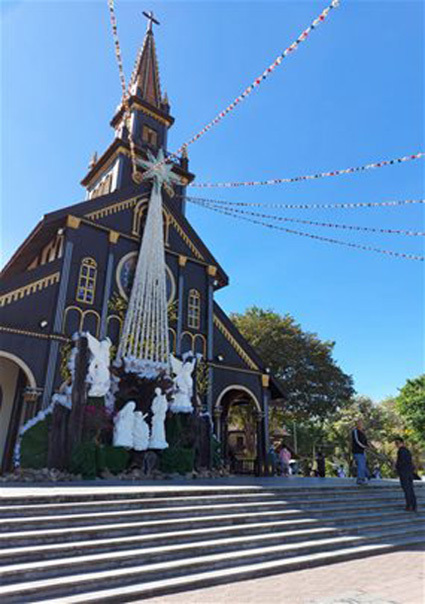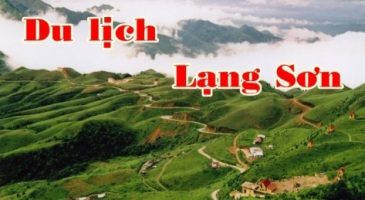 |
| A view of Bien Ho Lake. – Photos: Nhan Tam |
The first destination we visited was the old pine forest which is 20 kilometers from Pleiku City. Locals named a path lined by hundred-year-old pine trees in the forest in Nghia Hung Commune “Love Street” because of its romantic setting. Strolling on the one-kilometer street in the warm spring sunshine and taking some photos with these ancient trees were the first great experiences to gain.
On the left of the street is a vast tea hill that used to be part of the first tea plantation in the French colonial time. We walked on the tea hill with bare foot and picked young tea buds, totally immersing ourselves in nature.
We then walked to Buu Minh Pagoda at the end of the “Love Street.” In fact, the religious complex surrounded by tea and coffee fields is the first of its kind in Gia Lai Province.
On the second day, we travelled to Mang Den Town in Kon Tum Province, which is 1,200 meters above sea level. The town is home to Dak Ke, also known as Toong Ro Poong Lake covering around three hectares. The big lake is associated with a legend of seven lakes and three cascades in Mang Den.
Given the all-year-round cool weather, Mang Den can be called a land of agricultural products. E Ban Farm in Mang Canh Commune behind Pa Sy Cascade is a place where travelers may witness how these products are planted and harvested. Moreover, the 30-hectare farm features mesmerizing scenery as it is sandwiched between two hills adjacent to a primary forest.
On the following day, we visited Bien Ho, a.k.a. T’Nung Lake. We travelers were enchanted by the crystal clear water giving charming views along a path leading to Bien Ho. We fully enjoyed the poetic beauty of Bien Ho when standing on stone steps at the end of the path. Since the statue of Avalokiteshvara was built in 2018 there, more and more tourists who are pilgrims have visited this destination.
 |
| Charnel house at Kep Village. |
Aside from the greenery spaces, local culture is one of the highlights in the two Central Highlands provinces. Our tour guide told us that to know more about the culture and rituals of ethnic groups, visitors should spend time in local charnel houses. During this leg of the trip, we visited Kep Village’s charnel houses. There, we were impressed by many statues of persons with sorrowful face, pregnant women, moms carrying children on their backs, and the like. Jrai ethnic people believe that death is not the end, but the start of a new life. That’s why the charnel house has such statues symbolizing the new life.
The year of the death and the year of the corpse’s removal are inscribed on the charnel house. During nine years before a charnel house is removed, family members of the dead person would visit the charnel house, prepare daily meals to worship him or her and keep the charnel house clean. Every month, they have to worship the deceased person and have a drink with him or her at the grave hut.
Apart from this unique cultural custom, Yaly hydropower plant and the Wooden Church were also worth an exploration.
 |
| Wooden Church in Kon Tum Province. |
The Wooden Church, a.k.a. the Kon Tum Cathedral, in Kon Tum Province was built in 1913. It is a wooden structure whose architecture mixes Roman style with that of Ba Na ethnic group. It took us a half day to take picture as every corner of the church has their own beauty.
Meanwhile, Yaly hydropower plant by the Sesan River is the biggest one in the Central Highlands region. The way leading to the hydropower plant offered fantastic views of mountain ranges stretching to the horizon. The main entrance of the plant opened up a wonderful panorama of a large reservoir as well as the Sesan River beneath.
It was such an interesting experience when traveling in the 600-meter tunnel passing through a mountain, which is in fact part of a modern hydropower plant. The underground tunnel is home to four giant generators and a ventilation system operating round the clock.
Then, we decided to finish this trip by traveling to the peak of Ham Rong Mountain. Unfortunately, we could not reach the peak because entering the mountainous area there was not permitted.





























